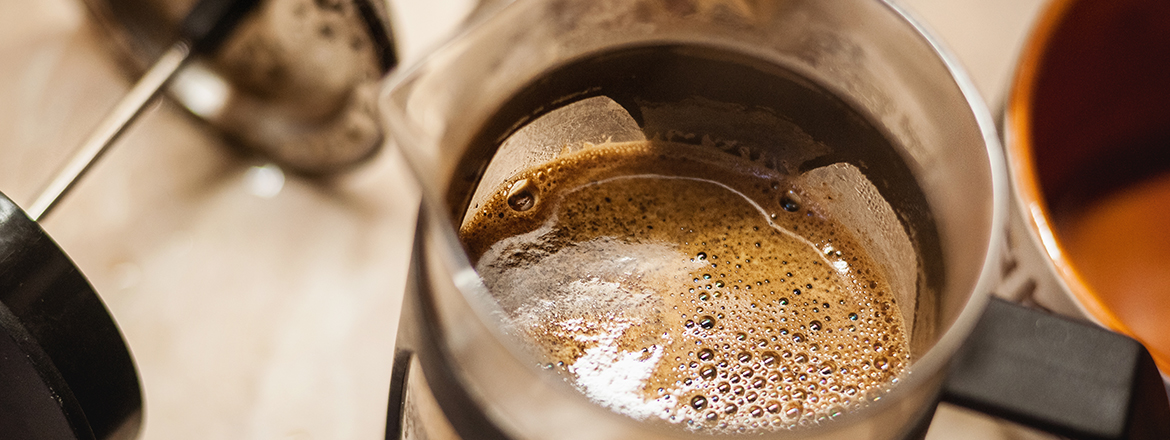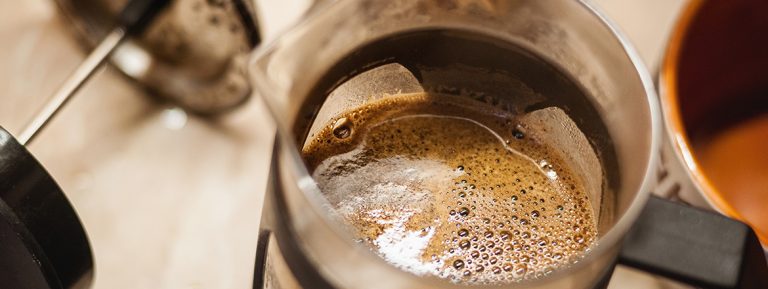We believe there are two things that drive us in life: First, the never-ending quest for perfection. Second: coffee. But what if you try to combine these two things? Imagine that you should make the perfect coffee – and not with a fully automatic coffee machine, which supposedly knows and can do everything better, but with a French press. Real craftsmanship, precision, weighing the coffee powder to the exact gram… does the thought of it already bring the first beads of sweat to your forehead? It doesn’t have to be – perfection is in the nature of French Press coffee, so it’s easier to achieve than you think.
Regardless of whether you want to use a French press in the office or prefer to devote yourself to the fine art of brewing coffee at home: Buying a French press is always a great idea. Why? Because you get maximum output (great coffee) with minimal effort (few accessories). The customization of taste. is the great strength of the French Press coffee maker. Of course, the basics include the French press as well as a coffee grinder, a scale, a kettle and the coffee beans of your choice. Real experts are also equipped with a water thermometer.
Coffee for the French Press: Which one is the right one?

To the frequently asked question of which coffee is best suited for the French Press, everyone has to answer with their own taste. For many coffee lovers, the French Press is an opportunity to try out particularly exotic types of coffee, others rely on coffee from the local small roaster and still others are guided by recommendations from their fellow human beings.
Much more important than the choice of coffee type, however, is the quality, i.e. the condition of the coffee when it is associated with the French Press. Here, the freshly ground coffee is a must for connoisseurs in order to be able to fully enjoy the desired aromas.
Making the coffee from the Frech Press
Fortunately, you don’t have to exhaust yourself to grind the perfect French Press coffee with the hand grinder – a coarse grind, similar to sea salt, is sufficient. Ideally, your coffee grinder should have a disc or conical grinder. This creates an even grinding result, which in turn makes the expected taste of the coffee from the French Press more predictable.
On to the next step: Rinse the French Press coffee pot with hot water beforehand and fill it with 60 to 70 grams of the black gold that you have just ground for each liter of water used. And now it gets exciting: The water that has been boiled in the meantime must now have a temperature of exactly 96°C before it is quickly poured onto the coffee – keyword water thermometer. And if you’re already handling measuring instruments, you can start the stopwatch right away, because after four minutes it’s time to stir. Immediately afterwards, begin to push the plunger of the French Press down in one smooth motion. Patience is truly a virtue here, otherwise if you press too fast and too hard, the coffee will end up everywhere except on the bottom of the French press.
What comes out now is the ready-to-drink, incomparable, aromatic, PERFECT coffee from the French Press – assuming you don’t leave it in the French Press. Then there is a great danger that the coffee will continue to brew and become bitter. Hence our tip: Only brew as much coffee as you want to drink, or transfer the coffee to another container. Coffee specialties from the French Press require a few extra steps, which you can certainly do with ease.
Coffee from the French Press compared to the fully automatic coffee machine

Fully automatic coffee machines adjust the brewing temperatures, proportions and degree of grinding of the beans to the desired drink, thus ensuring optimal coffee enjoyment. In comparison, French press preparation is a process that requires a little more attention. Espresso, latte macchiato, cappuccino, flat white, or café crèma – you can have your personal favorite coffee in no time at the touch of a button. Grinding with the French Press coffee grinder can be a bit more time-consuming.
The French Press coffee maker can be used flexibly, is mobile and light. In its basic form, the coffee machine is already equipped with all the technical requirements for coffee production and, depending on the model, has different additional functions such as the simultaneous preparation of several drinks or the energy-saving mode. However, this also requires a permanent, fixed place.
What basically happens after every cup of coffee is cleaning – there is no difference between the fully automatic coffee machine and the French Press coffee maker. However, when it comes to cleaning, the French Press coffee maker has to be cleaned thoroughly by hand. In most cases, the fully automatic coffee machine takes over the cleaning of its used components fully or semi-automatically. Some parts of the coffee machine have to be dismantled and cleaned by hand, but the self-cleaning functions require special cleaning agents that have to be bought and refilled at regular intervals. Thus, compared to the French Press coffee maker, the fully automatic coffee machine does not necessarily require more cleaning, but at least it involves additional costs for the cleaning agents.

